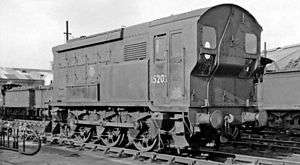British Rail Class D3/12
British Rail class D3/12 was a class of three experimental diesel-electric shunting locomotives designed by Richard Maunsell of the Southern Railway in 1937. They quickly proved their effectiveness, and although they were not immediately replicated due to the advent of the Second World War, the class were the basis for a larger class of similar locomotives introduced by Oliver Bulleid in 1949.
| Southern Railway diesels 1–3 British Rail Class D3/12[1] | |||||||||||||||||||||||||||||||||||
|---|---|---|---|---|---|---|---|---|---|---|---|---|---|---|---|---|---|---|---|---|---|---|---|---|---|---|---|---|---|---|---|---|---|---|---|
 Ex-SR 0-6-0 Diesel-electric shunter 15202 at Hither Green Locomotive Depot, looking north-east in the Locomotive Yard. 12 March 1960 | |||||||||||||||||||||||||||||||||||
| |||||||||||||||||||||||||||||||||||
| |||||||||||||||||||||||||||||||||||
| |||||||||||||||||||||||||||||||||||
| |||||||||||||||||||||||||||||||||||
Background and Construction
Once the UK economy began to improve in the mid 1930s, the Southern Railway had further need for heavy shunting locomotives in its marshalling yards around London. The Z class steam locomotives had proved successful for this task but Maunsell wanted to compare their performance with diesel-electric alternatives. He therefore sought authorisation for the construction of three experimental locomotives for use in the busy Norwood marshalling yard where there was a continuous need for such locomotives. No private manufacturer was in a position to build the new locomotives and so they were jointly constructed by the Southern Railway's Ashford works, who constructed the framing, cabs and bodywork, and English Electric Ltd of Preston, who fitted the traction motors. The three locomotives were also provided with duplicate controls to enable them to be driven by one man from either side of the cab. They were delivered during September and October 1937.[2]
Operation
After a few teething problems, the class quickly proved the advantages of diesel electric shunters in terms of effectiveness, cost-saving, and driver comfort. Although at £7,275 they cost £1,100 more to build than a Z class steam locomotive, each one saved about £1,700 per year in operating costs. They could be used continually day and night for six days each week at Norwood without any service requirement beyond refuelling.[3] They were however found to be too slow for their secondary task of freight transfers around the congested passenger lines in the London area, although perfectly well suited to this traffic on rural lines.
As a result of these experiments Maunsell's successor, Oliver Bulleid, received authorisation to build a further eight members of the class in July 1939 but this order was quickly cancelled as a result of the outbreak of the Second World War.[4]
Between 1941 and 1945 the locomotives were commandeered by the War Department for use on the Martin Mill military railway to haul cross-channel gun installations and ammunition. (Diesel locomotives were required for this task as they would not give away their position to enemy gunners.) They were returned to the Southern Railway in 1945.[4]
Following the formation of British Railways in 1948, twenty-six similar, but lighter locomotives were constructed to Bulleid's design. These later became British Rail Class 12. The three original locomotives continued their traditional work around London. Two of the locomotives were however loaned to the Western Region between 1951 and 1953 for use at the Acton marshalling yard. After replacement at Norwood by more modern locomotives they worked as shunters at Hither Green marshalling yard, at Eastleigh and Ashford works. One was also tried out at Lancing Carriage Works in 1961 as a replacement for the aged "Stroudley Terrier" but was found to be too slow.
Although they were still in good operating condition, the locomotives were withdrawn in November and December 1964, as by then the Southern Region had many modern replacements. None have been preserved.
Numbering
The original intention was to number the locomotives 958 to 960, following on from the steam locomotives of the Z class, but as delivered they were numbered 1 to 3 in a separate list from the SR's steam locomotives.[3] They were later renumbered by British Railways 15201–15203.[5]
Footnotes
- Details from Marsden 1981, pp. SR: 1–3
- Bradley 1975, pp. 51–53.
- Bradley 1975, p. 51.
- Bradley 1975, p. 52.
- Bradley 1975, p. 53.
References
- Bradley, D. L. (1975). Locomotives of the Southern Railway. Railway Correspondence and Travel Society. ISBN 0-901115-30-4.CS1 maint: ref=harv (link)
- Marsden, Colin (1981). The diesel shunter: a pictorial record. Oxford: Oxford Publishing Company. ISBN 0860931080.CS1 maint: ref=harv (link)
- Strickland, David C. (September 1983). Locomotive Directory: Every Single One There Has Ever Been. Camberley, Surrey: Diesel and Electric Group. p. 63. ISBN 978-0-9063-7510-5. OCLC 16601890.
- Ian Allan ABC of British Railways Locomotives, winter 1962/3 edition, page 229